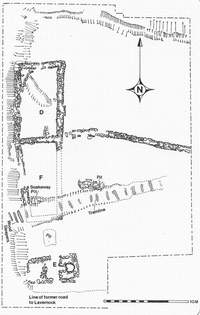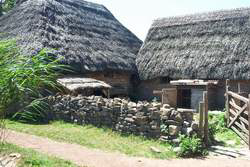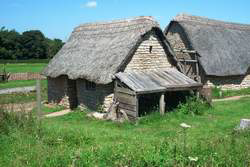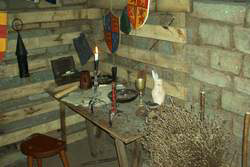Abandoned Communities ..... Cosmeston
We now move on six centuries to the re-discovery of the village. At the end of the 1970s there were plans to develop the local area as a country park. Two large quarries were no longer used, and the aim was to turn them into lakes. Ruins traditionally known as the castle mound were thought to be the site of Cosmeston’s manor house, and there was speculation among archaeologists that the remains of a village might lie nearby. Trial excavations confirmed the existence of the manor house and revealed the foundations of other medieval buildings. The development of Cosmeston Country Park went ahead, but it excluded the area where medieval buildings had been found.
More systematic excavation was organised by the Glamorgan and Gwent Archaeological Trust under the leadership of Gareth Dowdell. Between 1983 and 1988 several buildings on each side of the medieval road through Cosmeston were explored.
The findings are summarised in Newman R and Parkhouse J, The Cosmeston Medieval Village Project, History and Archaeology Review, 1989, 4, 5-15.
It may be helpful if I consider together the discoveries made by the archaeologists and the way in which each building was interpreted and reconstructed. A large part of the aim of the reconstruction was to educate the public in medieval building methods, lifestyle, social structure, agriculture, and technology. The biggest difficulty facing anyone intent on rebuilding is that much of the evidence gained through documents and archaeology is uncertain or contradictory, yet reconstruction can only go ahead if definite decisions are made. Questions then arise whether the decisions can be justified by the evidence, and to what extent the presentation of the site should recognise uncertainties. There may be a danger that decisions and presentation will be unduly influenced by the wish to attract large numbers of visitors.
The first buildings to be reconstructed occupied two crofts on the south east side of the medieval road running through Cosmeston. On the more northern of the two crofts (croft 3), a complex of three buildings around a courtyard was revealed. The complex was interpreted by the archaeologists as a farmstead comprising a house, a barn, and a byre or store. Pottery on the site and an Edward I penny found in a construction trench indicated that the complex was built in the early fourteenth century.
Today the complex is known as the Reeve’s House. Such a designation leads easily into a description of the function of the reeve (an official who managed the land on behalf of the lord of the manor) and the method of his appointment (by annual election among the freemen of the village), and from there into a wider account of the social structure characteristic of a feudal village. There is, however, no evidence at all that the house was occupied by a reeve, apart from the fact that as it is part of a complex of buildings and not a single longhouse its owner may have been relatively well off. In any case it is not clear whether the designation implies a home set aside for whoever was reeve (unlikely in view of the fact that the election for reeve took place every year) or whether it just happened to be the house where a particular reeve lived.
The current reeve is Walter. His wife is Charlotte, and they have three children. For more information on Walter, Charlotte, their achievements, and their marital difficulties, read The Villagers of Cosmeston In The Year of Our Lord MCCCL, a booklet available from the Cosmeston Visitor Centre.
On the adjacent croft the remains of two dwellings and what the archaeologists called a kilnhouse have been discovered. The two dwellings share a single wall. At the time of the excavation it was proposed that one was built at an earlier date and then replaced by the second. As they are both on a single croft that would seem a reasonable interpretation. Both houses have, however, been reconstructed, and we are now told that they are the first example in Wales of semi-detached housing.
The more southerly of the two houses lies close to the kilnhouse. This small building has two parts, one of which was interpreted by the archaeologists as possibly a faggot oven for baking. It has been duly restored as a bakery, and on busy days 120 loaves of bread may be baked there. The house next to it is now the Baker’s House, and is just big enough to incorporate a tavern at one end.
More detailed decisions had to be taken about methods of construction and building materials. In the buildings mentioned so far no stone window frames were found, and it was therefore assumed the frames were made of wood. The absence of roof tiles was taken to indicate that the roofs were thatched. All walls were made out of stone, and the discovery of a door jamb suggested that the stone walls were at least 1.65 metres high. However, there are at least two possible roof designs that fit the archaeological evidence. The buildings have in fact been reconstructed with stone walls 1.65 metres high with a wooden frame above the walls that supports the roof. An alternative possible design would have been higher stone walls with the roof keyed directly into them.
More systematic excavation was organised by the Glamorgan and Gwent Archaeological Trust under the leadership of Gareth Dowdell. Between 1983 and 1988 several buildings on each side of the medieval road through Cosmeston were explored.
The findings are summarised in Newman R and Parkhouse J, The Cosmeston Medieval Village Project, History and Archaeology Review, 1989, 4, 5-
It may be helpful if I consider together the discoveries made by the archaeologists and the way in which each building was interpreted and reconstructed. A large part of the aim of the reconstruction was to educate the public in medieval building methods, lifestyle, social structure, agriculture, and technology. The biggest difficulty facing anyone intent on rebuilding is that much of the evidence gained through documents and archaeology is uncertain or contradictory, yet reconstruction can only go ahead if definite decisions are made. Questions then arise whether the decisions can be justified by the evidence, and to what extent the presentation of the site should recognise uncertainties. There may be a danger that decisions and presentation will be unduly influenced by the wish to attract large numbers of visitors.
The first buildings to be reconstructed occupied two crofts on the south east side of the medieval road running through Cosmeston. On the more northern of the two crofts (croft 3), a complex of three buildings around a courtyard was revealed. The complex was interpreted by the archaeologists as a farmstead comprising a house, a barn, and a byre or store. Pottery on the site and an Edward I penny found in a construction trench indicated that the complex was built in the early fourteenth century.
Today the complex is known as the Reeve’s House. Such a designation leads easily into a description of the function of the reeve (an official who managed the land on behalf of the lord of the manor) and the method of his appointment (by annual election among the freemen of the village), and from there into a wider account of the social structure characteristic of a feudal village. There is, however, no evidence at all that the house was occupied by a reeve, apart from the fact that as it is part of a complex of buildings and not a single longhouse its owner may have been relatively well off. In any case it is not clear whether the designation implies a home set aside for whoever was reeve (unlikely in view of the fact that the election for reeve took place every year) or whether it just happened to be the house where a particular reeve lived.
The current reeve is Walter. His wife is Charlotte, and they have three children. For more information on Walter, Charlotte, their achievements, and their marital difficulties, read The Villagers of Cosmeston In The Year of Our Lord MCCCL, a booklet available from the Cosmeston Visitor Centre.
On the adjacent croft the remains of two dwellings and what the archaeologists called a kilnhouse have been discovered. The two dwellings share a single wall. At the time of the excavation it was proposed that one was built at an earlier date and then replaced by the second. As they are both on a single croft that would seem a reasonable interpretation. Both houses have, however, been reconstructed, and we are now told that they are the first example in Wales of semi-
The more southerly of the two houses lies close to the kilnhouse. This small building has two parts, one of which was interpreted by the archaeologists as possibly a faggot oven for baking. It has been duly restored as a bakery, and on busy days 120 loaves of bread may be baked there. The house next to it is now the Baker’s House, and is just big enough to incorporate a tavern at one end.
More detailed decisions had to be taken about methods of construction and building materials. In the buildings mentioned so far no stone window frames were found, and it was therefore assumed the frames were made of wood. The absence of roof tiles was taken to indicate that the roofs were thatched. All walls were made out of stone, and the discovery of a door jamb suggested that the stone walls were at least 1.65 metres high. However, there are at least two possible roof designs that fit the archaeological evidence. The buildings have in fact been reconstructed with stone walls 1.65 metres high with a wooden frame above the walls that supports the roof. An alternative possible design would have been higher stone walls with the roof keyed directly into them.
Two
Archaeologists’ plan of the farmstead on Croft 3
The Reeve’s House
Plan of the buildings on Croft 4
The bakery
The tavern inside the baker’s house
The Reeve’s desk





